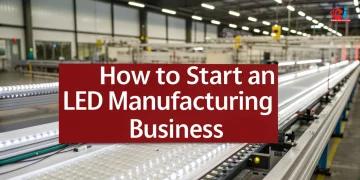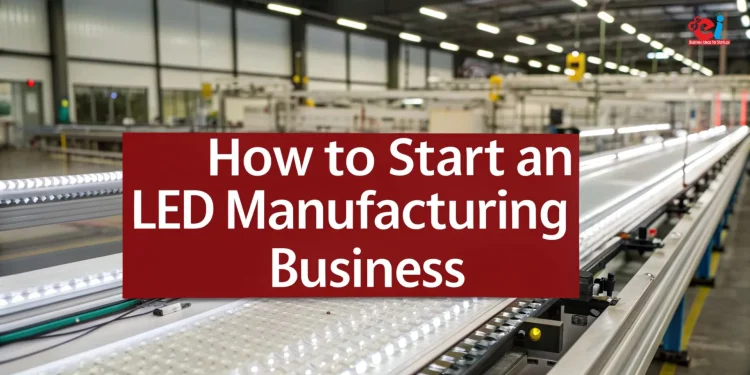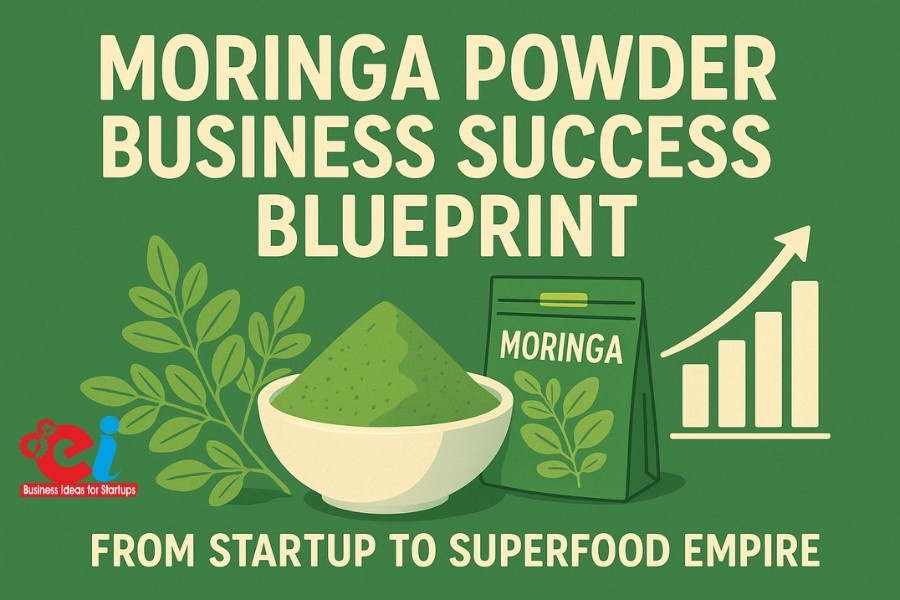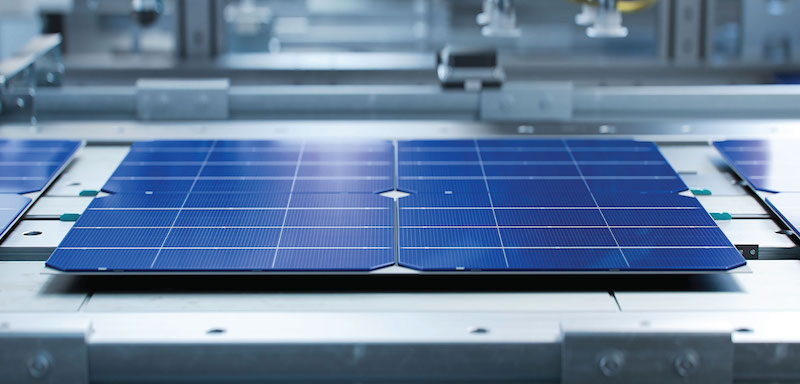Why LED Manufacturing is a Game-Changer for New-Age Entrepreneurs
In recent times, LED Manufacturing Business lighting has evolved from a luxury option to an everyday necessity, thanks to the increasing consciousness of cost-efficiency, energy conservation, and environmental accountability. In India’s industrial and entrepreneurial ecosystem, LED manufacturing stands out as a promising opportunity–especially for those looking to enter scalable and future-proof sectors.
LEDs, also known as Light Emitting Diodes, are not just low-energy lighting solutions that are low-energy. They are robust, small, compact, and are available in a variety of forms suitable for commercial, residential, automobile, industrial and other applications. While the government is pushing to eliminate inefficient lighting and the global market are moving towards green alternatives, the demand for LEDs continues to increase.
For entrepreneurs who are first generation this industry offers an easy path to build an enterprise that is able to meet the needs of domestic demand, and increasing global significance. What makes it more profitable is the broader ecosystem of support for policy as well as raw material access and opportunities for technology transfer available in India.
This article will provide you with the basics of LED manufacturing from current trends in the market to the basic manufacturing process. This will equip you with the information needed to begin and develop your own company within this exciting industry.
Related: Top 10 Small Scale Manufacturing Business Ideas
The Indian LED Market: Growth Forecast and Demand Potential
The lighting industry of India’s LED manufacturing has witnessed a massive change in the last decade, growing from a small segment into a multibillion-rupee business. As of 2014, LED lighting only accounted for a small percentage of the total sales of lighting; however, today they are the dominant part of the market with more than 80% market share.
The dimension of the Indian LED manufacturing industry was more than Rs30,000 crore in 2023. With the continuing adoption of LEDs in commercial, government, and household sectors, projections suggest that this market will nearly double by 2029 and reach between Rs60,000 and Rs65,000 crore. This growth forecast is backed by a hefty CAGR of 13 percent in the five years to come.
Many factors have contributed to the rapid growth of demand. The first is that government schemes such as UJALA along with UJALA and the Street Lighting National Programme (SLNP) have led to LED manufacturing the preferred option to power public infrastructure. Large-scale procurement of LEDs for roads, villages municipal bodies, as well as housing societies has resulted in an overall demand that grows every year. In addition, the growing infrastructure and urbanization mean that each new commercial or residential property will likely use LED lighting systems as a standard.
Beyond the borders of India There is a growing demand from countries of Southeast Asia, the Middle East and Africa for low-cost but reliable LED lighting. Indian manufacturers are strategically placed to meet this demand with competitive pricing and local engineering talent as well as access to the raw material.
There’s a lot to be gained by manufacturing the final product. With India becoming increasingly self-reliant in electronic manufacturing, there’s a huge demand for components like LED drivers, PCBs with metal-core as well as plastic housings and heat sinks. Entrepreneurs who are entering the market are now able to benefit from manufacturing both components and products to support the growing ecosystem.
Policy Support and Industry Ecosystem: A Manufacturing-Friendly Environment
One of the most significant advantages entrepreneurs can reap from entering LED production is the support for industry policy. The Indian government by way of its Ministry of Electronics and Information Technology (MeitY) has rolled out a number of programs to lower barriers and increase profitability for manufacturers in India.
The Production Linked Incentive (PLI) Scheme for white goods which comprises LED components, such as driver chips for LEDs and PCBs, provides incentives for sales that increase. These incentives can help lower production costs while promoting technology advancements and value enhancement within India.
In addition, a variety of states have established Electronics Manufacturing Clusters (EMCs) which provide subsidized land power, water, and land supply. Karnataka, Andhra Pradesh, Uttar Pradesh, and Tamil Nadu are among the most prominent states that are actively encouraging Manufacturing parks for LEDs.
Customs duty exemptions for specific raw products and concessional GST rates for energy-efficient lighting and R&D grant from institutions such as SIDBI and NSIC aid in easing the financial burden on businesses that are just starting.
The growing demand in India also means that LED companies that focus on local sales won’t have depend on exports to remain viable. The combination of demand pull, policy push, and increasing environmental awareness makes LED manufacturing one of the most entrepreneur-friendly sectors in Indian manufacturing today.
Choosing What to Manufacture: Product Segmentation and Opportunities
LED manufacturing isn’t a universally applicable industry. Entrepreneurs are able to begin small with basic products and later expand into more lucrative segments. In the beginning LED bulbs and tube line of light assembly are simple to set up, with the demand being generated by every home, shop and public building.
For those who have a greater technical bandwidth, making lighting fixtures for streets, lights and downlights and panel lights are able to secure more lucrative contracts from institutions and government departments as well as real developers of real estate. These lights typically require higher brightness, high-end motors, and robust housings. This makes them perfect for entrepreneurs who want to differentiate themselves through quality.
Beyond lighting for general purposes there are new areas which have the potential to grow over time. Smart lighting, where LED lights are connected through apps sensors, apps or voice assistants is increasing rapidly in the urban market. In the same way, solar-powered LED lighting are being utilized in the rural roads, infrastructure and remote health centers.
Those with access to tool-and-die or molding facilities can also focus on component manufacturing–especially PCBs, drivers, and plastic enclosures–which are in constant demand by other LED assemblers. This can allow entrepreneurs to gain access to B2B markets but also investigate manufacturing opportunities in OEM for national companies.
Related: How to Start a Successful Business of Automotive Paints?
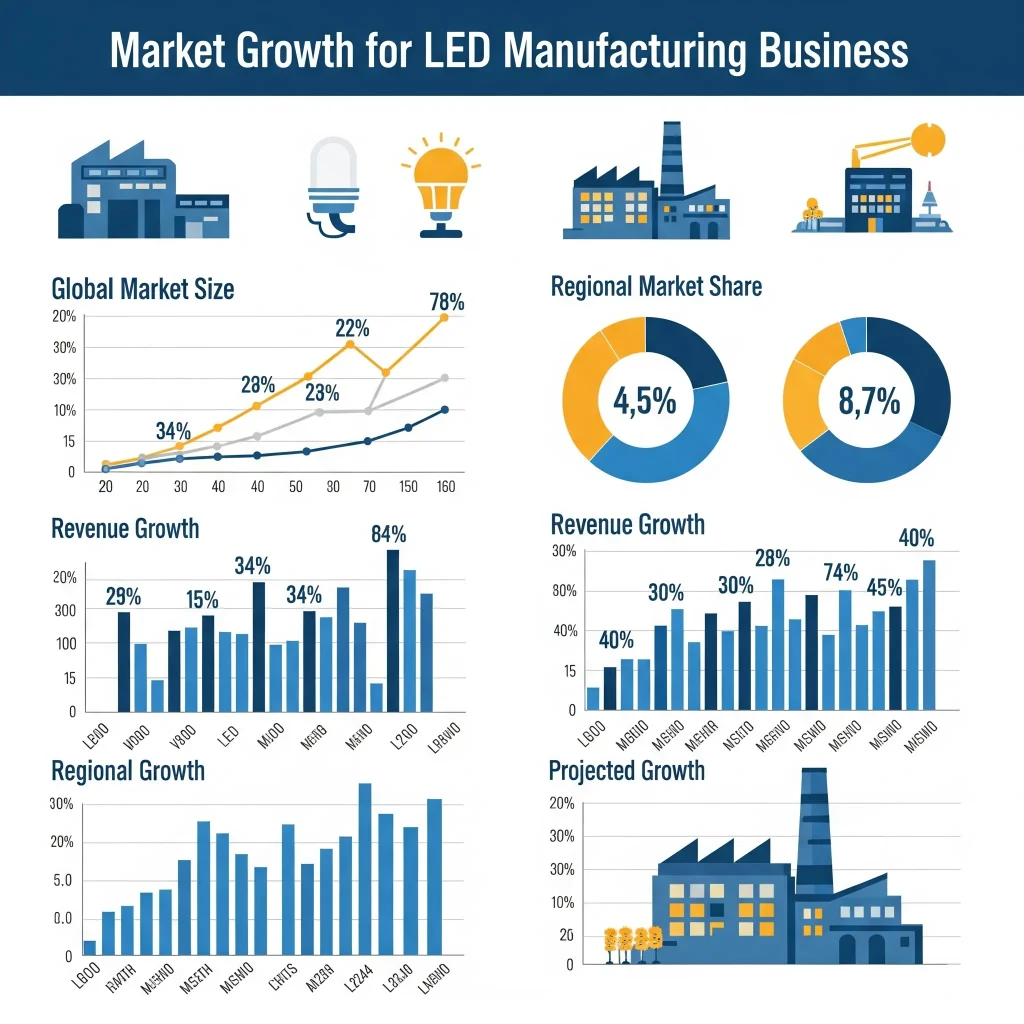
Manufacturing Process of LED Lights: A Step-by-Step Look
The process for the LED light manufacturing process varies according to the kind of bulb however the fundamental steps remain the same. For instance, the manufacturing of a typical LED bulb requires thermal management, electronic assembly and a mechanical housing. Below is a summary of the manufacturing procedure, that can be customized to different types of LEDs.
The process begins by sourcing basic materials like LED chips and resistors and printed circuit boards (PCBs) as well as electronic drivers. The components are purchased from reputable suppliers or imported, based on the quality and size of the project.
After the components are in possession after which after, the surface-mount (SMT) procedure is employed to secure electronic components on the PCB. It involves applying solder paste and putting in components with the help of automated pick-and-place machines, then passing the board through an oven for reflow. In this step, close care is taken to avoid soldering imperfections as well as cold joints or short circuits.
The next step is to integrate with the driver circuit. It controls the current flow and voltage to ensure that the LED is working safely and efficiently. After the PCB and driver have been connected, the LED is put into its housing, which is usually constructed of thermoplastic or aluminum material. The housing also houses the diffuser, which distributes the light evenly and shields this circuit against moisture and dust.
After the physical assembly testing and quality control is crucial. Every unit is tested for luminous output and the temperature of color, tolerance to voltage and the power factor. Other tests may be conducted to ensure heat control (to ensure that early failure is prevented) and conformity with Indian or international certification standards like BIS, CE, or RoHS.
Finally, the final product is packed then labeled and sent to retailers or distributors. Packaging and branding are especially crucial to those who want to be competitive with established market players because the visual appeal and trust of customers affect purchase frequency.
Operational Challenges and How to Overcome Them
Like all manufacturing businesses LED production also has its own set of difficulties. The most common challenge for startups is ensuring the same quality, particularly when they are sourcing components from several suppliers. A defective driver circuit or a poor quality diffuser can cause a major problem for a perfectly designed product. This is why selecting the right vendor, Quality inspection, selection of the right vendor, and testing on the internal side are crucial.
Another challenge for operations is managing the price-driven landscape. With major companies offering low-cost products, startups could struggle to maintain high-end quality and profit. The trick is to identify the uniqueness of their product–for instance, a longer warranty or smart lighting features, or energy efficiency–and establish confidence with the first customers.
It can also be a problem. It is the Bureau of Indian Standards (BIS) requires certification of LED lighting products that are available in India. Testing laboratories are scattered in major cities, but the process of certification requires the documentation of technical requirements and understanding of regulatory requirements. Entrepreneurs need to plan for the timeframes required to be certified and incorporate them into their plan to market.
After-sales services and distribution require attention. Business owners who make investments in strong supply chain partnerships as well as customer support systems usually surpass those who rely only on strategies based on price.
For more information, check out these related videos
The Road Ahead: Opportunities in Smart and Specialized LED Segments
When the industry matures, basic LED bulbs will have low margins. However, the advancement of intelligent lighting systems, solar-integrated and sensor-based lighting is opening up opportunities for products with higher value. Architectural and urban planners and developers of infrastructure are increasingly seeking intelligent lighting systems that are able to adapt to changing usage patterns and the conditions of the environment.
Similar to industrial lighting for cold storage, warehouses, and automotive workshops needs large-lumen LEDs with high-lumen output. These are not as crowded and provide great opportunities for niche companies.
Another new field includes LED lights for horticulture and agriculture which uses specific light wavelengths that are utilized to boost the growth of plants. They require expertise however they offer huge margins because of their uniqueness in technology.
How NPCS Can Help You Launch Your LED Manufacturing Business
Niir Project Consultancy Services (NPCS) offers highly precise Market Survey cum Techno-Economic Feasibility Reports on Manufacturing projects using LEDs. These reports assist entrepreneurs in understanding the demand for their product, technical specifications, and legal requirements.
NPCS also provides tailored advice regarding raw materials, manufacturing processes, as well as plant layout plans, to ensure your business is set with a solid foundation.
Through its experience in the industry, NPCS enables entrepreneurs to examine the practical viability and financial viability of establishing LED manufacturing units, be it for local sales or exports.
Which business to start? How to choose a business idea?
Key Takeaways: A Bright Business Idea for the Future
Manufacturing LEDs in India isn’t only a lucrative business venture, it’s an investment for an era of sustainability and digital infrastructure in addition to green tech. The entrepreneurs who take action today will be part of a global and national shift towards efficiency in energy, and if they take the right steps, they can create a successful export-ready industrial brand.
The industry’s relatively low barriers to entry as well as an energizing policy environment and a rising market demand, make it a great choice for first-time entrepreneurs as well as experienced manufacturers looking to diversify their business. With a solid knowledge of the process, the demand, and the ecosystem — along by utilizing the expertise of experts such as NPCS, you’ll be able to transform this brilliant idea into an effective business.
